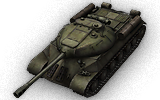Comparing: 110 vs. IS-3

From the mid-1940s to the 1950s, Soviet engineers attempted to modernize the IS-2 tank. The IS-2U variant, developed in November 1944, was conceived to have a reinforced frontal hull with a plate configuration resembling that of the IS-3. In the mid-1950s the design project was passed to China and became the basis of further Chinese tank development. |

Mass production of the vehicle started in May 1945. On September 7,1945, IS-3 tanks took part in the Allied Victory Parade through Berlin. A total of 1170 vehicles were manufactured by the end of 1946, when production was canceled. From 1948 through the late 1950s, the tanks underwent a number of modernization refits. |
||
| Modules | |||
| Auto select |
|
|
|
|---|---|---|---|
| Turrets | |||
| Guns | |||
| Engines | |||
| Suspensions | |||
| Radios | |||
| Main Characteristics | |||
| Tank data page | Tank data page | Tank data page | |
| Tier | VIII | VIII | |
| Battle Tiers | 8 9 10 | 8 9 10 | |
| Price | 1 | 2,568,500 | |
| Hit Points | |||
| Signal range | |||
| Speed Limit | 40 km/h | 38 km/h | |
| Speed Limit Back | 15 km/h | 15 km/h | |
| Weight | |||
| Load limit | |||
| Crew |
|
|
|
| Armor | |||
| Hull Armor |
|
|
|
| Turret Armor | |||
|
|
|||
| Mobility | |||
| Engine Power | |||
| Horse power / weight | |||
| Traverse Speed | |||
| Max Climb Angle | |||
| Hard terrain resistance | |||
| Medium terrain resistance | |||
| Soft terrain resistance | |||
| Fire Chance | |||
| Engine Type | |||
| Turret | |||
| View Range | |||
| Turret Traverse | |||
| Traverse Arc | |||
| Armament | |||
| Damage (Explosion radius) | |||
| Penetration | |||
| Shell Price | |||
| Shell Speed | |||
| Damage / min | |||
| Rate of Fire | |||
| Reload time | |||
| Clip | |||
| Accuracy | |||
| Aim time | |||
| Elevation Arc | |||
| Ammo Capacity | |||
| Camo value | |||
| Stationary | % | % | |
| In motion | % | % | |
| When Firing | % | % | |
| Battle performance | |||
| Accuracy | % | % | |
| Neto Credits Income | |||
| Winrate | % | % | |
| Damage dealt | |||
| Kills per Battle | |||
| More stats @ vbaddict.net | More stats | More stats | |